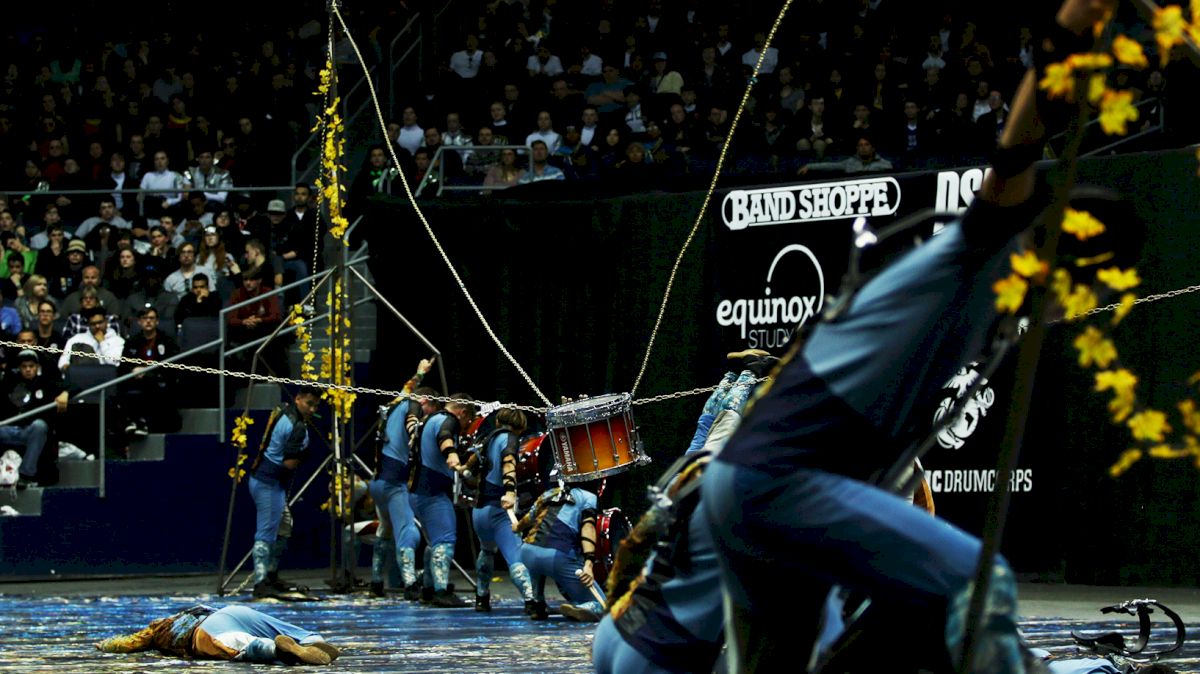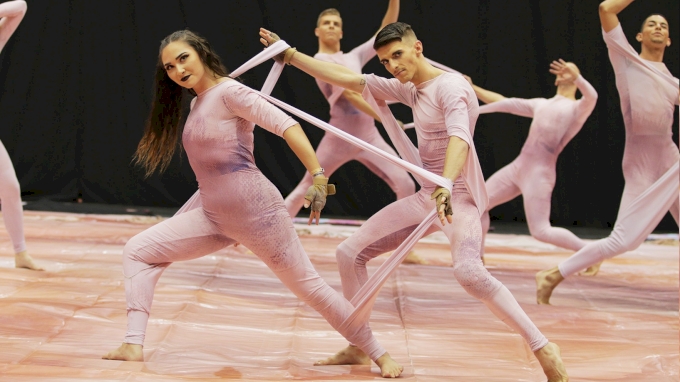Tarp vs. Turf: Comparing Indoor Percussion To Outdoor
Tarp vs. Turf: Comparing Indoor Percussion To Outdoor
Dan Schack delves into the differences between indoor percussion and outdoor percussion design and training philosophy—especially in DCI and WGI.

Unlock this article, live events, and more with a subscription!
Already a subscriber? Log In
Dan Schack is the Battery Coordinator/Choreographer of Carolina Crown Drum and Bugle Corps and the Creative Director of George Mason University Indoor Drumline. Outside of his musical endeavors, Dan is pursuing a Ph.D. in English at the University of Delaware.
Whether you are a contemporary or traditional drum corps fan, there is no denying that the indoor marching activity has seeped its way outside, infiltrating every corner of drum and bugle corps and marching band.
In the last five years, DCI and WGI shows have grown more similar than ever. You can silo this convergence into a number of concepts, including but not limited to: theatrics/narrative structure, costuming, individual solos/small ensembles, integration of electronics/mics, and overall intellectual depth.
This is the future, and it has arrived.
Rather than resisting the inevitable, I will use this platform to consider and embrace the ways in which indoor percussion has influenced the outdoor medium. I will look at what differences and similarities are to be found between the two, and perhaps where we are headed next as an overall activity.
Raising Performance Quality
An area we see the most influence between the different spaces is the enhancement of performance quality. The removal of headgear in outdoor marching has unveiled a new tier of skill for performers on the football field.
The immersion and totality of modern show design are requiring a move away from arbitrary costuming choices such as the traditional shako with wool uniforms. We are seeing more and more groups don something different each year or do away with a head piece entirely, revealing the performers beneath.
While it is obvious that the scale of the performance is quite different between indoor and outdoor marching, the convergent nature of WGI and DCI is overall raising the confidence and performance efforts of percussionists to a whole new level. Color guards, in particular, have already set the standard in this way.
We have come to expect color guards to "reinvent" themselves every year as a supplement to a show’s holistic concept. With the continuous rise of WGI percussion and the implementation of WGI winds, we should expect to see even more conceptual "weight" placed on the shoulders of percussion and brass performers in outdoor marching.
I feel it would be dated, if not voluntarily ignorant, to dismiss the possibility that social media has added to the increased importance of the individual performance quality in outdoor marching.
It is important to recognize the way social media has further supplied widespread access to the field-level performance. It’s inevitable that students in bands and drum corps recognize the presence of media platforms (FloMarching included) and the possibility for a little bit of “band fame.”

Staging With Accessibility In Mind
I’ll just come out and say it—the judging systems for DCI percussion and WGI percussion are inherently very different.
Because of this, getting your drumline more points on a DCI sheet means creating access for the percussion judge on the field and clear readability for the Music Analysis (MA) judge up top. Visual designers must create physical openings so that a field judge can easily find the correct position to read and reward a moment.
Exposures behind the back hash often go unread by the field percussion judge because of this. Many designers know that on a first read, a judge may only hang out near the front ensemble, so placing drum features in their proximity is a sure way to get evaluated in the early season.
The WGI stage, though, is much smaller. Judges have the luxury of sitting and absorbing the show and its elements somewhat holistically from a very different vantage point, in the arena seats. Although there is much debate on where the music judge should sit for WGI, each judge can really access any part of the show they want using just their eyes.
This means that designers do not need to program with visual exposure to the judges in mind, inevitably opening up new creative possibilities.
Choreographic Style
Indoor percussion designers who keep full immersion in mind are able to find concepts that allow a customized and homogenous choreographic style to emerge through the big picture. Big picture ideas work best when they can trickle all the way down into the "small picture" details.
We, as an activity, are moving beyond the days of arbitrary body movement that adds visual enhancement simply through alignment and punctuation. The most innovative groups, in fact, reinvent and revisit their choreographic style every year. How they move, with what qualities, and what postures, must all be filtered through the lens of the newest concept.
Outdoor drumlines are quickly headed in this direction. While certain groups engineer more or less choreography than others, it is clear that movement style is becoming an even more critical part of building an identity for outdoor marching ensembles. Overall, more groups are attending to their choreographic style and embracing how it can reinforce the show concept.
It’s pretty rare these days for a drumline to be visually detached from the rest of the show, but a quick glance back into the drum corps archives will remind us that this was not always the case. Shows are becoming more and more integrated visually, and that is evident through how much is being asked of every section.
Picking And Choosing Inside vs. Outside
Part of designing an outdoor show, especially a drum and bugle corps' show, is negotiating and weighing how much exposure each section receives.
The entire music ensemble (brass, percussion, electronics) cannot simply play over each other the entire show, nor can audience members and judges read the intricacies of every section at all times. Designers manage "who, where, when, and how" individual sections are featured so that maximum points can be accumulated in those captions (see the above discussion on accessibility).
Simultaneously, designers must think about the bigger picture and how to get General Effect (GE) points, which weigh in more heavily on the sheets than individual performance captions.
All of this boils down to a lot of thought that has to go into visually and musically featuring sections in an effective way. Ideally, that will lead to a holistic result reflected in the effect caption, rather than just a cool drill move or brass feature that will only be shown in said caption's score.
This is exemplary of two things: the growing integrated nature of all sections in an outdoor group, and attempting to navigate the judging system with the necessary overlap between captions.
In indoor percussion, WGI specifically, this problem is much less prevalent.
There are certainly reasons to give individual sections features, and effect points can be gathered through any orchestration, but the WGI judging system does not directly reward section exposure. The judges do not have the obligation to concretely award individual features or exposures.
The judges, as a whole, are more concerned with the total package and how the elements come together to create a cohesive whole.
Furthermore, this difference in the reward system means designers do not have to fight for exposure time, but can rather focus on the total product. Of course, one can easily argue that the differences between how to expose voices stem from the difference in size/scale/performer population between DCI and WGI, which is a reasonable statement.
That being said, there is nothing to do about these inherent differences, but we may educate ourselves on the differences between these judging systems so we are more equipped to evaluate the work the judges do in these two very different paradigms.
Volume Production
Similar to many of my points above, the amount of actual volume a drumline can, or should, produce is highly predicated on the other musical elements present in an ensemble.
In WGI, drumlines are only “competing” for sound with the front ensemble and electronics. There are fewer acoustic instruments to be heard through, so the percussion ensemble is the only sonic character that needs balancing. Therefore, indoor drumlines may not need to worry about projecting their sound as much and instead can refocus their efforts on technical variety, nuance, and risk-taking.
This is not the case for DCI.

For example, many people criticize Carolina Crown’s drumline for playing too loud. While working for this corps, I learned that what the music fans may perceive as too loud in the parking lot can barely be heard through the massive volume output of the hornline on the field, where we are actually judged.
We are required to train the students to play with a certain volume so that we have a chance of balancing with the brass in tutti musical moments. On the other hand, this need to play at a certain volume can negatively affect us in the percussion caption, which does not take the total musical program into account.
What may be negatively perceived in the percussion caption could be positively rewarded by the MA or GE judge that DO take the total product into account.
Outdoor drumlines and front ensembles must keep their musical presence in mind within and around the brass choir. This connects directly to my discussion of exposures, as these exposed windows are frequently the only time MA and GE judges can read the specifics of the percussion voice from the top. With the growing nature of electronic integration, an awareness of volume production and exposure, the issue of balance is heightened even further.
This discussion, more than simply pointing out the differences and similarities between WGI and DCI, reinforces the reality that judging percussion ensembles inside is a tremendously different experience than judging them outside. The differences between the judging systems lead to many of the differences that I have showcased in this essay. I do not have a way to bring these systems closer together, nor do I believe they necessarily should be the all that similar.
But, I do think it is important for us as designers, educators, students, and spectators to understand the fundamental differences so that we can engage with the activity with proper knowledge. Our ability to evaluate judge’s decisions and ultimately hold all of us accountable will make for better adjudication and better design.